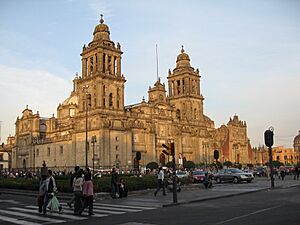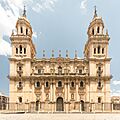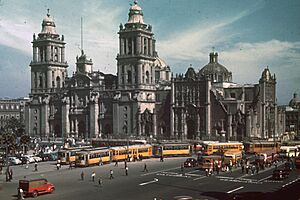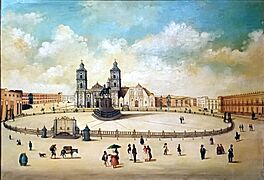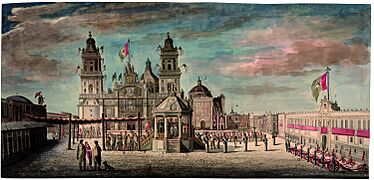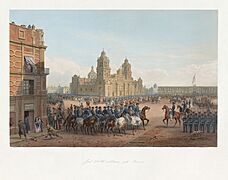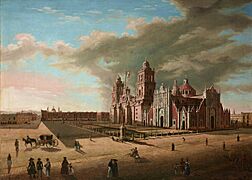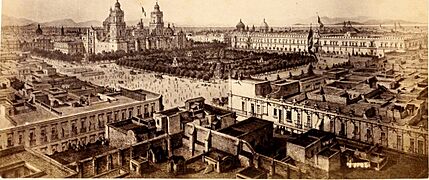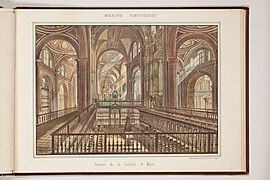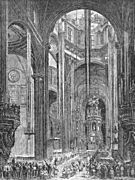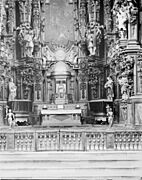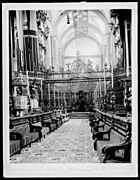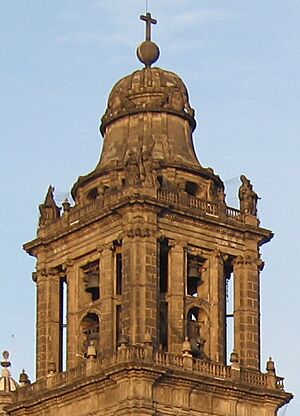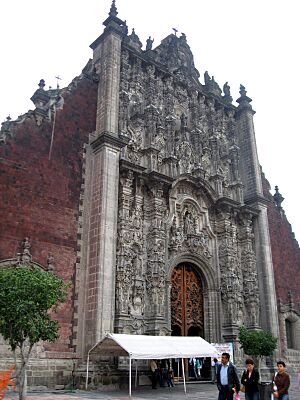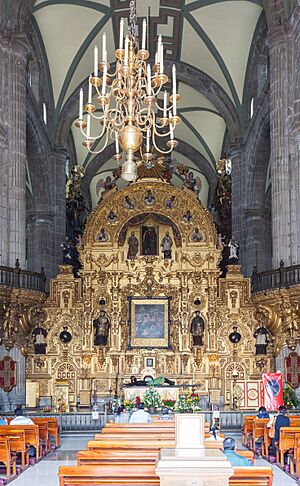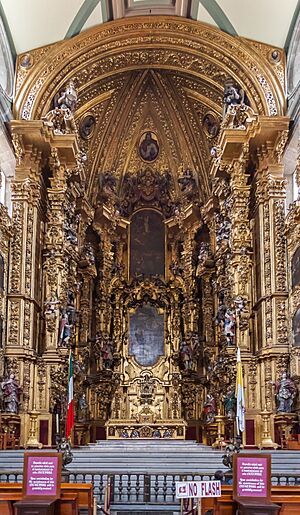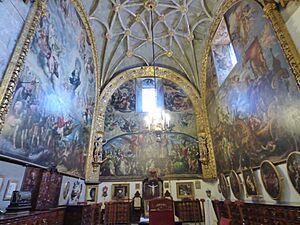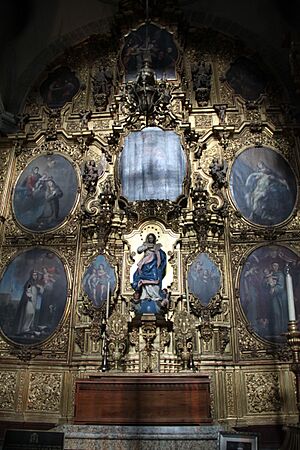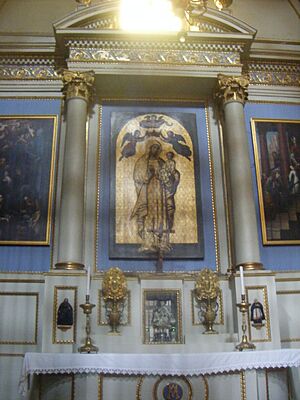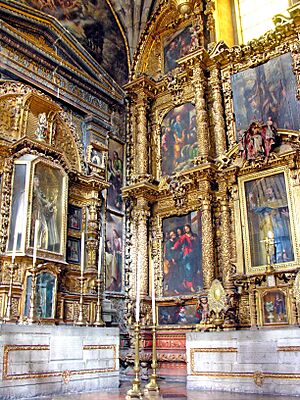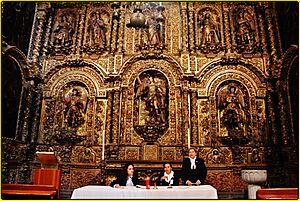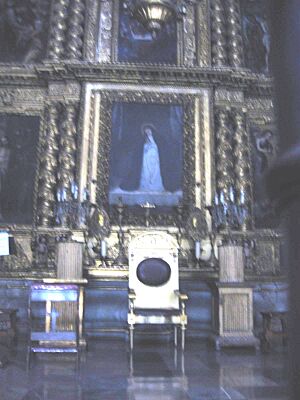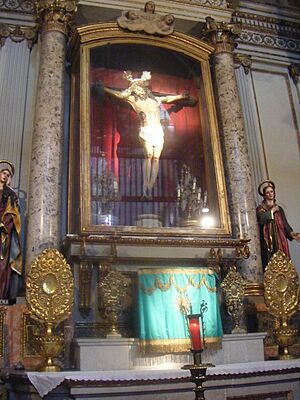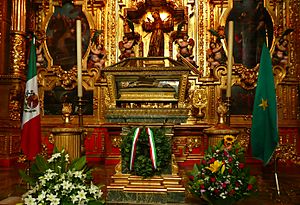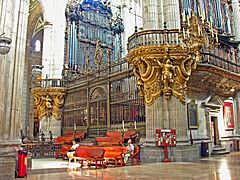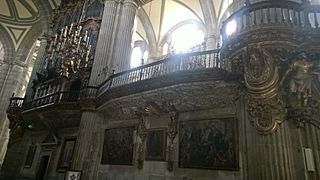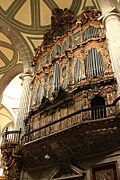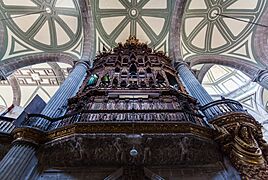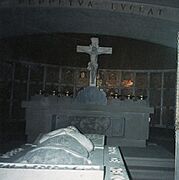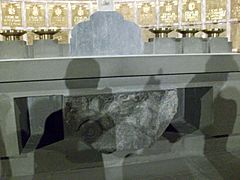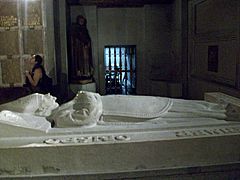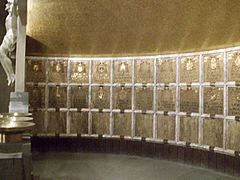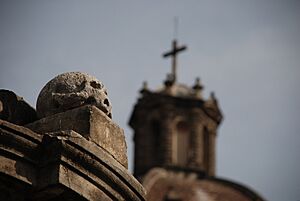Mexico City Metropolitan Cathedral facts for kids
Quick facts for kids Mexico City Metropolitan Cathedral |
|
|---|---|
| Metropolitan Cathedral of the Assumption of the Most Blessed Virgin Mary into Heaven | |
|
Catedral Metropolitana de la Asunción de la Bienaventurada Virgen María a los cielos (Spanish)
|
|
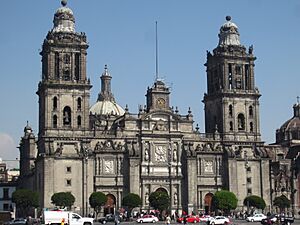
The cathedral in 2018
|
|
| 19°26′04″N 99°07′59″W / 19.43439420°N 99.13308240°W | |
| Location | Mexico City, Mexico |
| Denomination | Catholic Church |
| History | |
| Status | Cathedral |
| Dedication | Assumption of Mary |
| Consecrated | 2 February 1656 |
| Architecture | |
| Architect(s) | Claudio de Arciniega Juan Gómez de Trasmonte José Eduardo de Herrera José Damián Ortiz de Castro Manuel Tolsá |
| Style | Gothic, Plateresque, Baroque, Neoclassical |
| Groundbreaking | 1573 |
| Completed | 1813 |
| Specifications | |
| Length | 128 metres (420 ft) |
| Width | 59 metres (194 ft) |
| Height | 67 metres (220 ft) |
| Materials | Chiluca, stone, tezontle |
| Administration | |
| Archdiocese | Mexico |
The Mexico City Metropolitan Cathedral is a very important church in Mexico City. Its full name is the Metropolitan Cathedral of the Assumption of the Most Blessed Virgin Mary into Heaven. It stands in the historic center of Mexico City, right where the ancient Aztec city of Tenochtitlan used to be. It's also very close to the Templo Mayor, a major Aztec temple.
Building this huge cathedral took a very long time, almost 250 years, from 1573 to 1813! Because of this, many different architects and artists worked on it. This also means the cathedral shows a mix of building styles, like Gothic, Baroque, and Neoclassical. It's a special place that brought many generations and people together.
The cathedral has been the setting for many important moments in Mexican history. For example, emperors were crowned here, and some heroes of Mexico's independence were buried here for a time. It has also seen big changes in how the church and government work together.
The cathedral is about 59 metres (194 ft) wide and 128 metres (420 ft) long, reaching 67 metres (220 ft) high at its towers. It has two bell towers, a central dome, and three main entrances. Inside, there are five large naves (main sections) with 51 vaults and 40 columns. The two bell towers hold 25 bells in total. There are 14 chapels open to the public, each dedicated to a different saint. The cathedral also has two of the largest 18th-century organs in North and South America. Below the cathedral, there's a crypt where many past archbishops are buried.
Over the years, the cathedral has faced challenges. A fire in 1967 caused a lot of damage inside. Also, because it's built on soft clay soil, the building has been sinking unevenly. This made it one of the 100 Most Endangered Sites in the world for a while. However, major restoration work in the 1990s helped stabilize it, and it was removed from the endangered list in 2000.
Contents
- History of the Cathedral
- Outside the Cathedral
- Inside the Cathedral
- Altars of Importance
- The Sacristy
- Chapels of the Cathedral
- Chapel of Our Lady of the Agonies of Granada
- Chapel of Saint Isidore
- Chapel of the Immaculate Conception
- Chapel of Our Lady of Guadalupe
- Chapel of Our Lady of Antigua
- Chapel of Saint Peter
- Chapel of Christ and of the Reliquaries
- Chapel of the Holy Angels and Archangels
- Chapel of Saints Cosme and Damian
- Chapel of Saint Joseph
- Chapel of Our Lady of Solitude
- Chapel of Saint Eligius
- Chapel of Our Lady of Sorrows
- Chapel of the Lord of Good Dispatch
- Chapel of Saint Philip of Jesus
- Organs of the Cathedral
- The Choir Area
- The Crypt of Archbishops
- Restoration Efforts
- Cultural Importance
- See also
History of the Cathedral
The First Church Building
After the Spanish took over the Aztec Empire, they decided to build a church on the site of the Aztec's main temple. This was to show Spanish power in the new land. The first church was built between 1524 and 1532. It used stones from the destroyed Aztec temples.
This first church was quite small and simple. People soon felt it wasn't grand enough for the growing capital city. So, in 1544, church leaders decided to build a much bigger and more impressive cathedral.
- The cathedrals of Jaén and Valladolid inspired that of Mexico City.
-
View of the Jaén Cathedral.
-
Project of the Valladolid Cathedral.
Starting the Big Project
In 1552, it was agreed that the Spanish King, local leaders, and native people would all help pay for the new cathedral. The first plans for the new building began in 1562. The archbishop at the time, Alonso de Montúfar, wanted a huge church with seven naves, similar to the Seville Cathedral in Spain.
However, building such a massive structure on swampy ground was very difficult. They tried using cross beams, but it was too expensive and the city kept flooding. So, they switched to an older local method: pushing many solid wooden logs deep into the ground. This helped create a strong base. The design was also changed from seven naves to five.
The construction officially began in 1573. The new cathedral was built around the existing small church. As the new building grew, the old church was slowly taken down. The first parts built were the chapter house and the sacristy. It took about a hundred years to finish the vaults and naves.
Building Through the Centuries
The ground was muddy and unstable, so builders used lighter materials like tezontle (a reddish volcanic rock) and chiluca stone. In 1615, the walls reached half their final height. Work on the inside began in 1623.
In 1629, a big flood hit Mexico City, stopping construction. Water reached two meters high in the main square. There was talk of moving the cathedral to higher ground, but they decided to continue at the same spot. The interior was finally finished and dedicated in 1667.
By 1675, the central part of the main front was done. It featured a statue of the Assumption of Mary, to whom the cathedral is dedicated. The bell towers and main entrances continued to be built over the next few decades.
Not much work happened on the cathedral's exterior during the 18th century because the inside was already complete and being used. However, in 1787, architect José Damián Ortiz de Castro took charge of building the bell towers, the main front, and the dome. He designed the towers to be strong against earthquakes. After he passed away in 1793, Manuel Tolsá finished the work. Tolsá redesigned the dome to be taller and added statues representing Faith, Hope, and Charity to the main front. The entire cathedral was finally completed in 1813.
- Historical photographs of the cathedral.
-
View of the Plaza Mayor de México, 1797 by anonymous Mexican after Rafael Ximeno y Planes
-
General Scott's entrance into Mexico, 1847 by Carl Nebel
-
View of the cathedral between 1880 and 1887, when the Aztec sun stone was moved to the Museo de la Calle de Moneda
Outside the Cathedral
Main Entrances and Walls
The main entrance of the cathedral faces south. It's the tallest of the three main entrances. Statues of Saint Peter and Paul the Apostle stand by the columns. Above the doorway, there's a carving of the Assumption of Mary, which is what the cathedral is named after. At the very top, a clock tower has statues representing Faith, Hope, and Charity.
The west entrance was built in 1688 and rebuilt in 1804. It features images of the Four Evangelists. The east entrance is similar, showing a ship carrying the four apostles. This scene is called The ship of the Church sailing the seas of Eternity.
The northern wall is the oldest part of the cathedral, built in the 16th century. The carvings on all the entrances were inspired by the work of the Flemish painter Peter Paul Rubens.
Bell Towers
The bell towers were designed by José Damián Ortiz de Castro. They have bell-shaped roofs made of reddish volcanic rock and white stone. Manuel Tolsá finished the towers, adding the clock structure and the dome.
The cathedral has 25 bells. Eighteen are in the east tower, and seven are in the west tower. The biggest bell is called Santa Maria de Guadalupe and weighs about 13,000 kilograms (29,000 lb). Another large bell is Doña Maria, weighing 6,900 kilograms (15,200 lb). La Ronca ("the hoarse one") is named for its sound.
In 1947, a bell ringer died in an accident. The bell was then "punished" by removing its clapper, so it couldn't ring. It was called la castigada ("the punished one") or la muda ("the mute one"). In 2000, the clapper was put back.
In October 2007, a time capsule was found inside a stone ball in the southern bell tower. It was placed in 1742 to protect the building. The box held religious items, coins, and old papers. A new time capsule will be placed there when it's sealed again.
The Tabernacle
Next to the main cathedral is the Metropolitan Tabernacle. It was built between 1749 and 1760 by Lorenzo Rodríguez. It holds church records and clothes, and it's where people receive Eucharist and register as church members.
The Tabernacle is built from reddish volcanic rock and white stone. It has a Greek cross shape. Inside, different sections are used for the baptistry and the main altar. The main altar is very ornate, in the Churrigueresque style.
The outside of the Tabernacle is covered with many decorations, like cherubs, drapes, and carvings of fruits. These carvings symbolize religious offerings. There are also flowers, including the native chalchihuite.
The Tabernacle has two main entrances. The one facing the Zócalo is more decorated. It shows images of apostles, saints, and scenes from the Bible. The east entrance is simpler but also has figures from the Old Testament.
Inside the Cathedral
Altars of Importance

The High Altar
The original High Altar was removed in the 1940s. In 2000, a new, modern altar table was created to replace it.
Altar of Forgiveness
The Altar of Forgiveness is right at the front of the main nave. It's the first thing you see when you enter. It was designed by Jerónimo de Balbás.
There are two stories about its name. One says that people who were going to be executed would come here to ask for forgiveness. Another story is about a painter named Simon Pereyns, who was accused of saying bad things about the church. While in jail, he painted such a beautiful image of the Virgin Mary that he was forgiven.
This altar was slightly damaged by a fire in 1967 but has since been restored.
Altar of the Kings
The Altar of the Kings is at the very back of the cathedral. It was also designed by Jerónimo de Balbás and built between 1718 and 1725. It's very large, about 13.75 metres (45.1 ft) wide and 25 metres (82 ft) tall. Its size and depth earned it the nickname la cueva dorada ("the golden cave").
It's called the Altar of the Kings because it has statues of saintly kings and queens. At the bottom, there are six female saints who were queens. In the middle, there are six saintly kings. Between these kings, a painting shows the Adoration of the Magi, with Jesus as the "King of kings." The top part features a painting of the Assumption of Mary as a heavenly queen.
This altar was also damaged in the 1967 fire and has been under restoration since 2003.
The Sacristy
The sacristy is the oldest part of the cathedral. Its walls display large paintings by famous artists like Cristóbal de Villalpando and Juan Correa. These paintings show important religious scenes.
A statue of a crucifix with an ivory Christ image is in a niche on the north wall. Behind it is a mural of Juan Diego and Our Lady of Guadalupe. The sacristy used to hold Juan Diego's cloak, but it was moved after a big flood in 1629 to keep it safe.
Chapels of the Cathedral
The cathedral has sixteen chapels, each dedicated to a different saint. Fourteen of these chapels are open to the public. Each chapel was supported by a religious group.
Chapel of Our Lady of the Agonies of Granada
Built in the early 17th century, this chapel used to be the sacristy. It has a medieval style with two simple altarpieces. One painting shows Saint Raphael, Archangel and the young Tobias.
Chapel of Saint Isidore
This chapel was built between 1624 and 1627 and was once used for baptisms. Its ceiling has plaster figures representing Faith, Hope, Charity, and Justice.
Chapel of the Immaculate Conception
Built between 1642 and 1648, this chapel has an altarpiece dedicated to the Immaculate Conception. It's surrounded by paintings about the Passion of Christ. This chapel also holds the remains of Antonio Margil de Jesús, a Franciscan friar who spread Christianity in northern Mexico.
Chapel of Our Lady of Guadalupe
This chapel was built in 1660 and was the cathedral's first baptistery. It's decorated in a 19th-century neo-classic style. The main altar is dedicated to the Virgin of Guadalupe.
Chapel of Our Lady of Antigua
Built between 1653 and 1660, this chapel was sponsored by musicians. Its altarpiece has a painting of the Virgin, a copy of one from the Seville Cathedral.
This chapel is also home to the Niño Cautivo (Captive Child), a Child Jesus figure. It was brought from Spain but was captured by pirates. A large ransom was paid to get it back. People pray to this image for help with financial problems or addiction. Since 2000, it has also become a symbol for families seeking the return of kidnapped loved ones.
Chapel of Saint Peter
Built between 1615 and 1620, this chapel has three ornate Baroque altarpieces. The main altar is dedicated to Saint Peter, with paintings about his life. Another altar is dedicated to the Holy Family.
Chapel of Christ and of the Reliquaries
This chapel, built in 1615, has very detailed Baroque decorations. It was originally called the Christ of the Conquistadors. Over time, so many reliquaries (containers for holy relics) were placed on its altar that its name changed. Hidden compartments behind the paintings hold some of these relics.
Chapel of the Holy Angels and Archangels
Finished in 1665, this chapel is dedicated to the Archangel Michael. It has a large main altarpiece dedicated to the seven archangels.
Chapel of Saints Cosme and Damian
This chapel was built because these two saints were often prayed to during times of sickness. The main altarpiece is Baroque, likely from the 17th century.
Chapel of Saint Joseph
Built between 1654 and 1660, this chapel contains an image of Our Lord of Cacao. Its name comes from a time when native worshipers would give offerings in the form of cocoa beans. The main altarpiece is Baroque and from the 18th century.
Chapel of Our Lady of Solitude
This chapel was built to honor the workers who built the cathedral. It has three Baroque altarpieces. The main one is dedicated to the Virgin of Solitude of Oaxaca.
Chapel of Saint Eligius
Also known as the Chapel of the Lord of Safe Expeditions, this chapel was built by the first silversmith guild. It was redecorated in the 19th century. The image of Our Lord of Good Sending is here, named because many prayers here were answered quickly.
Chapel of Our Lady of Sorrows
This chapel, built in 1615, was remodeled in a Neo-classical style. The main altarpiece has an image of the Virgin of Sorrows. On the left wall, a ladder leads to crypts where most of Mexico's past archbishops are buried. The largest crypt holds the remains of Juan de Zumárraga, the first archbishop of Mexico.
Chapel of the Lord of Good Dispatch
This chapel opened in 1648 and was dedicated to the silversmiths' guild. Its decoration is in the neoclassical style from the early 19th century.
Chapel of Saint Philip of Jesus
This chapel is dedicated to Philip of Jesus, the only martyr from New Spain, who was crucified in Japan. It has a Gothic-style dome and a Baroque altarpiece. An urn here holds the remains of Agustín de Iturbide, who was briefly Emperor of Mexico. The heart of Anastasio Bustamante is also kept here.
Organs of the Cathedral
The cathedral has had many organs throughout its history. It now has two large 18th-century organs, which are among the biggest in North and South America. They are located above the choir walls. Both organs were damaged by the 1967 fire but were restored in 1978. They were restored again between 2008 and 2014 and are now fully playable.
The Choir Area
The choir is where the priests or a choir group sing. It's in the central part of the cathedral, between the main door and the high altar. It was built between 1696 and 1697. Its sides have 59 carvings of different saints. The railing around the choir was made in Macao in 1722.
- Choir and organs
The Crypt of Archbishops
The Crypt of the Archbishops is located under the floor, beneath the Altar of the Kings. A winding staircase leads down to it. Inside, there's a stone skull in the ancient Mexica style. This skull was placed at the base of a monument to Juan de Zumárraga, the first archbishop of Mexico.
The walls of the crypt have bronze plaques showing where the remains of most of Mexico City's past archbishops are located. The floor is covered with marble slabs that mark other burial spots. The cathedral also has other crypts and niches in its chapels where religious figures are buried.
- Crypt of the Archbishops of Mexico
-
Zumárraga tomb, in the Chapel of Our Lady of Sorrows
Restoration Efforts
The 1967 Fire and Repairs
On January 17, 1967, a fire caused by an electrical problem severely damaged the cathedral. The Altar of Forgiveness lost parts of its structure and three paintings. The choir area lost many seats and books. The two large organs were also badly damaged.
After the fire, restoration work began. Experts used old records and photos to repair the damage. They also worked on the cathedral's foundation, which was sinking unevenly, and fixed problems with the towers.
During the restoration in the 1970s and early 1980s, some interesting things were found. Fifty-one paintings were discovered behind the Altar of Forgiveness. Inside one of the organs, a copy of the document naming Hernán Cortés as Governor General of New Spain was found. Also, the burial place of Miguel Barrigan, the first governor of Veracruz, was discovered in a wall.
Work in the Late 20th Century
Mexico City is built on an old lakebed, so the ground has always been sinking. However, as the city grew and more water was taken from underground, the sinking sped up. Different parts of the cathedral were sinking at different rates, and the bell towers were tilting. Because of this, the cathedral was listed among the 100 Most Endangered Sites in 1998.
Major restoration work on the foundation started in the 1990s. Engineers dug under the cathedral and placed concrete shafts into the soft ground. This helped give the building a more solid base. These efforts have helped the cathedral sink more evenly and corrected the tilting towers.
21st-Century Work
After an earthquake in 2017, the cathedral needed more reconstruction to fix the damage. During this work, builders found 23 lead boxes containing religious items like small paintings and crosses. These boxes had notes saying they were found and reburied by masons and painters in 1810.
Cultural Importance
The cathedral is a symbol of Mexican culture and its colonial past. It was built on the site of an Aztec sacred area, using stones from their temples. This showed that the Spanish now controlled the land and its people.
For a long time, it was a religious center mainly for important families. After Mexico became independent, Emperor Agustin I was crowned here in 1822. Later, Emperor Maximilian I of Mexico and Empress Carlota of Mexico were also crowned at the cathedral in 1864.
The cathedral has also been a place for social and cultural events. It was closed for four years during a time when the Mexican government tried to limit the power of the church. The church reopened in 1930 after an agreement was reached.
The cathedral has also been a site for protests. Its bells have rung to show the church's disagreement with certain laws. In November 2007, some protesters entered the cathedral during Sunday Mass, causing church officials to close it for a few days. It reopened with new security measures.
See also
 In Spanish: Catedral Metropolitana de la Ciudad de México para niños
In Spanish: Catedral Metropolitana de la Ciudad de México para niños
- Cruz de Mañozca
- Catholic Church in Mexico
- History of Mexico City


